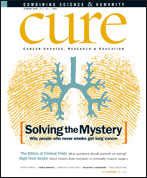Publication
Article
CURE
A Hole In The World
Author(s):
Dana Reeve's death revealed the other face of lung cancer.
In early March 2006, Dana Reeve’s death stunned the world. We were numbed and saddened. Dana died from lung cancer, days before her 45th birthday, and only months after her diagnosis. The individual narrative is compelling.
Dana Reeve is my sister. My sister married Superman. In 1995, a riding accident left her husband a vent-dependent quadriplegic. Superman paralyzed. And so on.
We held our collective breath. We cheered them on—amazed at their courage and their grace. Together they changed the landscape of paralysis and spinal cord injury, and their legacy continues today through the Christopher and Dana Reeve Foundation.
During her short life, Dana was revered as a caregiver and a patient advocate. Months before her diagnosis of stage 4 lung cancer, she was honored by the American Cancer Society as its “Mother of the Year.”
After her husband’s death in 2004, Dana strove to find a new balance—devoting her energy to their young son, Will, as well as to supporting the causes that she and Christopher had embarked on together. She focused on writing her autobiography and reviving her career as a singer. This is where the individual narrative of my broccoli-loving, blueberry-devouring, non-smoking sister ends, and the sickening tragedy enshrouding the disease of lung cancer begins. It is an abrupt transition, and alarming in its unceasing repetition.
Consider this: The majority of lung cancer cases, approximately 60 percent, are diagnosed in non-smokers. This includes former smokers who have admirably overcome this powerful addiction and never-smokers like my sister. A recent study in the Journal of Clinical Oncology confirms one’s anecdotal impression with stark clinical data, revealing the number of non-smoking women diagnosed with lung cancer is on the rise.
Approximately 25,000 people who have never smoked will be diagnosed with lung cancer, and nearly two-thirds of them are women. Now, imagine hearing Dana’s heart-wrenching story repeated by thousands of women and their families in 2007 alone.
Abrupt transitions. Alarming similar outcomes.
Lung cancer remains the leading cancer killer, accounting for one-third of all cancer deaths annually. Surrounded by stigma and lack of awareness, the disease kills at a steady rate. It is terribly underfunded and engulfed in a cloud of confusing media messages.Contributing to this is the stark reality that the disease has few survivors and is swift to kill. It leaves little window for the voices of its victims to be heard.
More than 160,000 Americans will die from lung cancer this year. Nearly twice as many women will die from lung cancer than breast cancer, and nearly three times as many men will die from lung cancer than prostate cancer. Since the National Cancer Act of 1971, coordinated and comprehensive research raised five-year survival rates for breast cancer to 88 percent, prostate cancer to 99 percent, and colon cancer to 64 percent. Yet no such effort for lung cancer has been undertaken, and its five-year survival rate is only 15 percent.
The vast majority of diagnoses, roughly 70 percent, are late stage, contributing significantly to lung cancer’s lethality. Yet lung cancer early detection, a key arrow in any cancer control quiver, remains mired in debate at the expense of those at high risk who could benefit today from low-dose CT scans.
Dana and every other person diagnosed with lung cancer and their families deserve better. In her memory, and the memory of all those who have died from this disease—smoker or not—let us come together to reverse the decades of stigma and neglect too long attached to lung cancer. I know it is what Dana would want us to do.
—Deborah Morosini, MD, sister of the late Dana Reeve, is a Lung Cancer Alliance Board member. Dr. Morosini currently works as a pathologist in research and development at AstraZeneca, and lives outside of Boston with her husband, Charles, and two sons.





